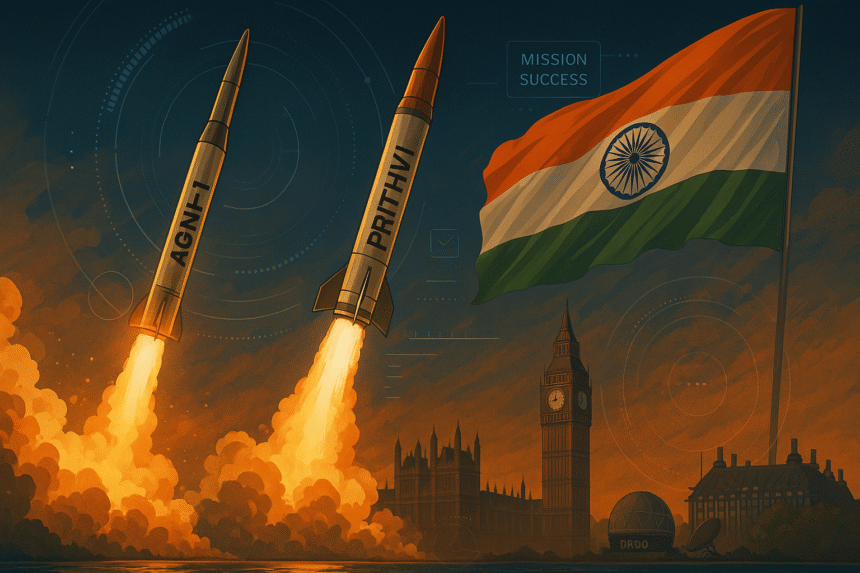“When diplomacy fails, deterrence speaks.”
– Welcome to missile week in India, where Agni and Prithvi just reminded the world who’s watching the skies.
India recently conducted successful tests of two nuclear-capable ballistic missiles — the Agni-1 and Prithvi-2 — reaffirming its military readiness and strategic deterrence capabilities. These tests, conducted under routine user trials, are more than just high-speed fireworks — they are statements of technological prowess, geopolitical messaging, and national preparedness.
- 🧨 Agni-1 Missile Test: The Firepower Behind the Name
- 🎯 Prithvi-2 Missile Test: Old Warrior, Still Sharp
- ⚙️ Why Are These Missile Tests Conducted?
- 🌏 Geopolitical Message: India’s Strategic Posture
- 🧠 Quick Recap: India’s Missile Family Tree
- 🚀 DRDO: The Brain Behind the Boom
- 🧪 What Happens During a Missile Test?
- 🎯 Agni vs. Prithvi: What’s the Difference?
- 📣 Public & Media Response
- 🔚 Final Thoughts: Fire, Earth, and Strategy
- 📌 TL;DR (Too Lazy? We Got You)
Let’s break it down, one supersonic launch at a time.
🧨 Agni-1 Missile Test: The Firepower Behind the Name
Named after the Hindu god of fire, Agni-1 is no lightweight.
- Range: Approx. 700–900 km
- Warhead Capability: Can carry both conventional and nuclear payloads
- Launch Platform: Road-mobile launchers
- Speed: It goes from zero to Mach real-quick
The latest Agni-1 missile test was conducted from a mobile launcher at APJ Abdul Kalam Island (off the Odisha coast). As per defense officials, the test met “all mission objectives with high accuracy.”
Translation?
The missile hit where it was supposed to hit. With deadly precision.
This matters because the Agni series forms the backbone of India’s nuclear deterrence, especially with neighboring countries like China and Pakistan always hovering in the backdrop of strategy maps.
🎯 Prithvi-2 Missile Test: Old Warrior, Still Sharp
Prithvi-2, on the other hand, is part of India’s first indigenously developed ballistic missile family.
- Range: Around 350–500 km
- Developed by: DRDO under the Integrated Guided Missile Development Program (IGMDP)
- Warhead: Capable of carrying 500–1000 kg, including nuclear
- Accuracy: Known for its pinpoint targeting
In this Prithvi-2 missile test, conducted from the Integrated Test Range, the launch reaffirmed the missile’s readiness for quick deployment and high-precision targeting.
So yes, while Prithvi may be an OG in India’s missile club, it’s clearly not ready to retire just yet.
⚙️ Why Are These Missile Tests Conducted?
Contrary to what action movies might suggest, missile tests aren’t about flexing for Instagram or triggering alarms. These are routine user trials conducted for several critical reasons:
- Validating system performance under real-world conditions
- Testing new upgrades to control systems, navigation, and telemetry
- Training armed forces to handle actual launch scenarios
- Reassuring the nation (and allies) about defense readiness
- Sending not-so-subtle signals to neighbors and geopolitical observers
In short, think of them as fire drills with megatons attached.
🌏 Geopolitical Message: India’s Strategic Posture
Let’s be real — timing is everything.
These missile tests come amidst:
- Tensions with China along the LAC
- A watchful eye on Pakistan’s military exercises
- A global environment where missile diplomacy is replacing ambassador handshakes
So, when India tests both Agni-1 and Prithvi-2 in quick succession, it sends a clear message:
“We’re calm, but we’re not sleeping.”
It’s not about aggression — it’s about credibility. And in global politics, credibility comes with payloads and precision.
🧠 Quick Recap: India’s Missile Family Tree
To fully appreciate this week’s fireworks, here’s a snapshot of India’s missile might:
| Missile | Type | Range (Approx) | Payload Type |
|---|---|---|---|
| Agni-1 | Ballistic | 700–900 km | Nuclear/Conventional |
| Agni-2 | Ballistic | 2,000–2,500 km | Nuclear/Conventional |
| Agni-3 | Ballistic | 3,000+ km | Nuclear/Conventional |
| Agni-5 | Intercontinental | 5,000+ km | Nuclear |
| Prithvi-2 | Ballistic | 350–500 km | Nuclear/Conventional |
| Shaurya | Hypersonic | 700+ km | Nuclear |
| BrahMos | Cruise | 300–800 km | Precision Strike |
And that’s just the shortlist.
India’s missile capability isn’t just about deterrence — it’s about multi-layered defense, strategic reach, and technological depth.
🚀 DRDO: The Brain Behind the Boom
Both Agni-1 and Prithvi-2 were developed by DRDO (Defence Research and Development Organisation) — India’s premier defense R&D agency.
From cryogenic engines to hypersonic glide vehicles, DRDO has evolved from humble beginnings into a tech powerhouse, placing India among a select group of nations with credible nuclear triads.
Every successful Agni-1 missile test or Prithvi-2 missile test is as much a scientific victory as it is a military one.
And don’t forget: this is also “Make in India” in its most literal (and explosive) form.
🧪 What Happens During a Missile Test?
If you think it’s just press button, boom, think again. Here’s what actually goes into a typical test:
- Pre-launch diagnostics and system calibration
- Real-time weather and wind condition assessments
- Telemetry links with tracking stations and radars
- Dummy payloads fitted to simulate actual scenarios
- Multiple agencies including DRDO, Strategic Forces Command, and armed forces coordinate in harmony
And all of this must happen within a tightly controlled window with observers from national security councils, research wings, and intelligence agencies monitoring every second.
One failure? Postponed.
One glitch? Grounded.
This is rocket science at its most disciplined.
🎯 Agni vs. Prithvi: What’s the Difference?
Here’s a comparison to clear the confusion:
| Feature | Agni-1 | Prithvi-2 |
|---|---|---|
| Range | 700–900 km | 350–500 km |
| Launch Type | Surface-to-surface ballistic | Surface-to-surface ballistic |
| Use Case | Medium-range deterrence | Tactical battlefield strikes |
| Mobility | High (road-mobile) | Moderate |
| Era Introduced | 2002 | 1996 |
While both are part of the Strategic Forces Command, Agni is like your long-range sniper, while Prithvi is your battlefield sharpshooter.
📣 Public & Media Response
Twitter/X is predictably thrilled:
“Agni fired. Prithvi confirmed. India’s defence is not just prepared — it’s poetic. #MissileMight”
“Agni: god of fire. Prithvi: goddess of earth. Who said India doesn’t believe in divine intervention?”
Even mainstream media hailed it as a “double validation of India’s nuclear capability.”
But more importantly, defense analysts see this as a quiet but firm message: India is maintaining its strategic minimum deterrence policy while upgrading its preparedness across all dimensions.
🔚 Final Thoughts: Fire, Earth, and Strategy
India’s dual test of the Agni-1 and Prithvi-2 ballistic missiles is more than a calendar event for the Ministry of Defence. It’s a reaffirmation of where we stand — technologically, tactically, and geopolitically.
Yes, we seek peace.
Yes, we follow no-first-use.
But if ever required — we’ll respond not with words, but with precision and power.
Because in a world where the balance of power is constantly shifting, a reliable deterrent is the best peace treaty.
📌 TL;DR (Too Lazy? We Got You)
- India successfully tested Agni-1 and Prithvi-2, both nuclear-capable ballistic missiles.
- Conducted as routine user trials, the tests met all objectives.
- These tests boost strategic deterrence against China & Pakistan.
- DRDO-developed missiles show India’s indigenous defense strength.
- It’s a message to the world: “India is calm, but capable.”












